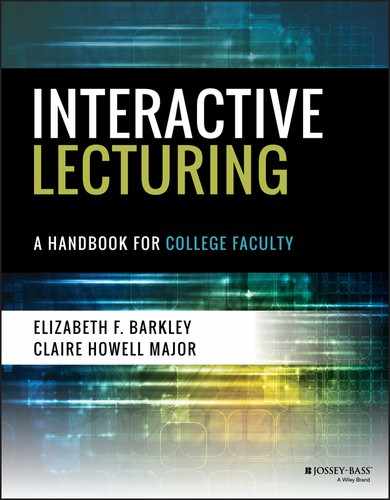ENGAGING LECTURE TIP 36
Value Display
By virtue of our roles as faculty members, students tend to confer high status on us and expect us to live up to it. We should honor their beliefs in us by striving to live up to their expectations. We can do this by working diligently to craft a lecture that adds value to student learning and then communicating the importance of the message through verbal and nonverbal methods.
Value Display communicates the lecture's importance to students and thus may help to improve students' interest and motivation. If you can communicate the reasons students should care about the topic, student motivation to put in the energy and effort required to learn will most likely improve.
The Value Display begins with your understanding of the importance of the topic yourself and your role in communicating that information to students. There are a few specific techniques that can help you.
Value Pitch Not all students will immediately recognize the importance of the lecture topic. A value pitch involves expressly stating the value of the lecture material and describing how students may be able to use the information in the future. For example, you might point out how it is foundational to understanding new content or is required understanding for students in that academic major.
Without Apology Sometimes lecturers apologize for what students have to learn. This most often happens when they are required to teach specific content that they do not particularly care for. A lecturer in such a situation might say something like, “OK, this is the boring part, but you have to know it, so . . .” or “We'll get through this technical part and move on to more interesting things soon.” Don't apologize for the lecture content. Don't acknowledge that it's boring. It is what it is. Own it, be enthusiastic, and figure out how to teach it.
Strong Voice Sometimes students break off into conversations. They can be taken with a point you have just made or they can simply be off topic. Don't talk over student conversations. Instead, as Lemov (2010) suggests, stand up and stand still. Use the power of quiet, and wait until students stop talking. Move closer to them if you have to. And if they simply don't stop, interrupt them and either ask them to share or ask them to stop. In this way, you signal that the lecture is important and that they need to hear it.
No Hijacking From time to time, multiple student questions or extended comments can have the effect of hijacking a lecture. Take questions, but don't let them completely sidetrack the lecture; if the content is important enough to share, you owe it to the students to finish. Answer questions concisely. If students continue to ask questions, tell them to hold their questions until the end of the lecture segment. Alternately if the questions seem to be coming from one student, ask the student to see you after class or during office hours; this will prevent other students from becoming irritated with the one student as well.
Example
Key References and Resources
- Ford, N., McCullough, M., & Schutta, N. T. (2012). Presentation patterns: Techniques for crafting better presentations. Boston, MA: Addison Wesley.
- Lemov, D. (2010). Teach like a champion: 49 strategies that put students on the path to success. San Francisco, CA: Jossey-Bass.
